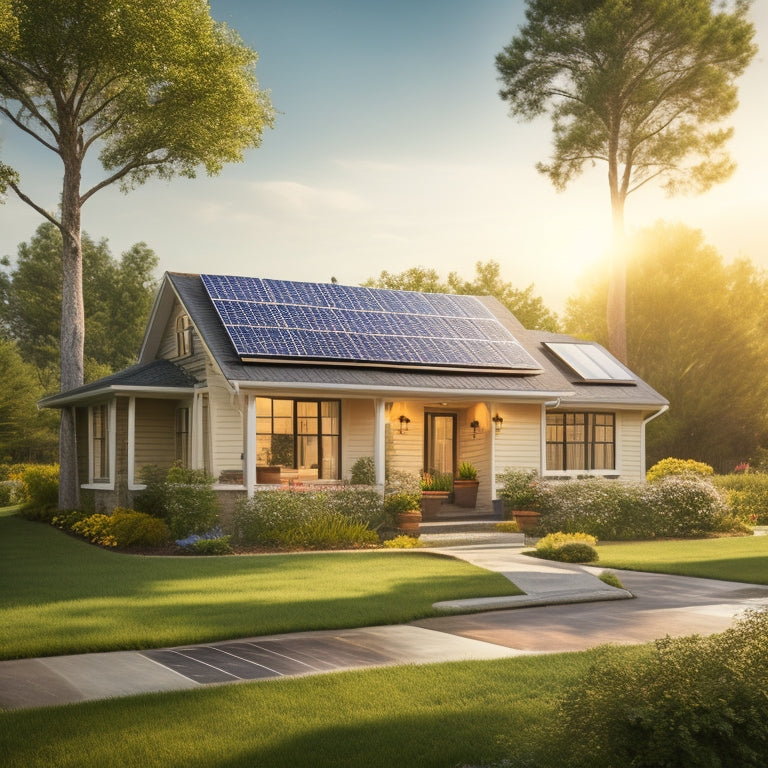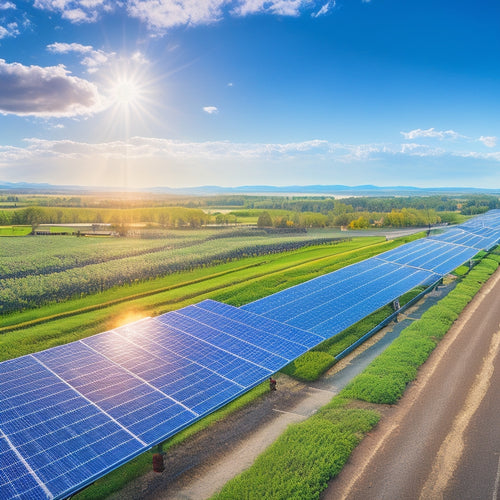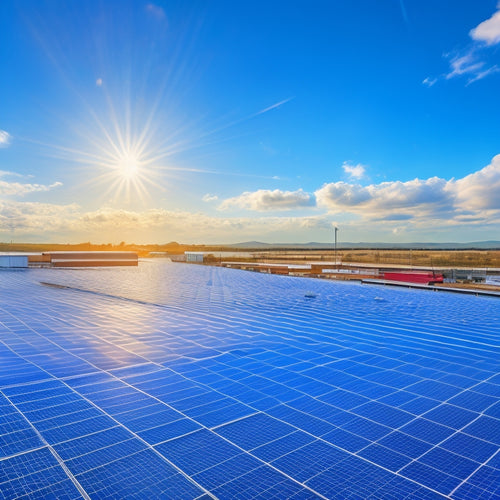
Powering Your Home With Solar Lighting
Share
You're taking the first step towards reducing your reliance on traditional power sources and minimizing your environmental footprint by powering your home with solar lighting, a clean and renewable energy solution that can greatly decrease your electricity bills. This innovative approach employs photovoltaic cells to convert sunlight into electrical energy, which is then stored in batteries for later use. By choosing the right solar panels, ensuring proper installation and maintenance, and taking advantage of cost savings and incentives, you'll be well on your way to energy independence. Now, investigate how to optimize your system for maximum efficiency and savings.
Key Takeaways
- Solar home lighting utilizes renewable energy, reducing reliance on traditional power sources and decreasing electricity bills significantly.
- Photovoltaic cells convert sunlight into electrical energy, which is stored in batteries for later use in powering light sources.
- Choosing the right solar panels involves considering efficiency ratings, cost, durability, and mounting and wiring requirements for optimal performance.
- Regular maintenance, including panel cleaning and inspections, ensures maximum solar efficiency and prevents performance issues.
- Solar lighting systems can provide significant cost savings and incentives, including federal and state tax credits, net metering, and increased property value.
Benefits of Solar Home Lighting
By utilizing the sun's energy, solar home lighting systems offer a unique opportunity to reduce your reliance on traditional power sources. This shift towards renewable energy provides several benefits, including increased energy independence.
You'll no longer be tied to the grid, and your electricity bills will decrease considerably. With affordable options like cheap solar batteries, solar home lighting systems have become more accessible to households and rural communities.
Additionally, solar home lighting systems have a minimal environmental impact, producing no emissions or pollution. This eco-friendly solution helps reduce your carbon footprint, contributing to a cleaner and healthier environment.
With solar lighting, you'll enjoy a reduced reliance on non-renewable energy sources, decreased energy costs, and a clear conscience knowing you're doing your part for the planet.
How Solar Lighting Systems Work
The photovoltaic (PV) cells in your solar lighting system convert sunlight into electrical energy, which is then stored in a battery for later use. This energy is used to power light sources in your home, providing a clean and efficient alternative to traditional energy sources.
The system components work together to optimize energy efficiency, reducing your reliance on the grid and minimizing your environmental impact. Careful selection of solar panels is essential for off-grid systems in independent homes or cabins, with system sizing considering energy usage, battery capacity, and local climate conditions.
Choosing the Right Solar Panels
When selecting solar panels for your home, you'll need to take into account three key factors: panel efficiency ratings, which affect how much energy you can generate; cost and durability, which impact your return on investment; and mounting and wiring requirements, which influence the installation process.
Additionally, it's crucial to assess the total system cost and take into account the installation and labor costs, as well as ongoing maintenance expenses, to guarantee a smooth and efficient installation.
You'll want to balance these factors to find the right panels for your needs and budget. By evaluating these critical factors, you can make an informed decision and get the most out of your solar lighting system.
Panel Efficiency Ratings
You're about to make a significant investment in solar lighting for your home, and choosing the right solar panels is vital to maximize energy output.
Panel efficiency ratings play an important role in this decision. These ratings indicate how well a solar panel converts sunlight into electrical energy. Look for panels with high efficiency ratings to get the most out of your investment.
-
Monocrystalline silicon panels: Offer high efficiency ratings (up to 22%) and are ideal for small to medium-sized systems.
-
Polycrystalline silicon panels: Provide moderate efficiency ratings (up to 18%) and are a cost-effective option.
-
Thin-film panels: Have lower efficiency ratings (up to 14%) but are more flexible and durable.
- Bifacial panels: Can increase energy conversion by up to 25% by utilizing light from both sides of the panel.
Cost and Durability
By the time you've narrowed down your solar panel options based on efficiency ratings, you're likely considering the cost and durability of each type.
The upfront installation costs are a significant factor, ranging from $2.50 to $3.50 per watt, depending on the manufacturer and quality.
However, it's crucial to balance these costs with the solar panel lifespan, which typically ranges from 25 to 30 years or more. A more expensive panel with a longer lifespan may provide better value in the long run.
Be sure to calculate the total cost of ownership, including maintenance and replacement costs, to make an informed decision.
Mounting and Wiring
Considering the total cost of ownership, you'll want to guarantee that your solar panels are properly mounted and wired to maximize their energy output.
Improper mounting and wiring can lead to reduced energy production, safety hazards, and even system failure.
To verify a successful installation, focus on the following key considerations:
-
Mounting techniques: Choose a secure and durable mounting system that can withstand environmental elements and support the weight of your solar panels.
-
Wiring safety: Confirm that all electrical connections are secure, insulated, and meet local electrical codes to prevent electrical shocks or fires.
-
System monitoring: Install a monitoring system to track your energy production and identify potential issues early on.
- Compliance with local regulations: Verify that your installation meets local building codes, permits, and regulations to avoid penalties or system shutdowns.
Installation and Maintenance Tips
You'll need to guarantee you're installing the right system for your specific needs, which involves considering factors like energy output and battery storage.
Proper mounting and wiring are also essential to prevent damage and guarantee ideal energy generation.
Choosing the Right System
Since solar lighting systems vary in design, functionality, and quality, selecting the right one for your home can be a challenging task, especially for those new to renewable energy.
When choosing a system, consider the following key factors to confirm you get the most out of your investment:
-
Assess your energy needs: Determine how much energy you need to power your home and choose a system that can meet those demands.
-
Check system compatibility: Verify the system you choose is compatible with your existing electrical infrastructure and can integrate with other renewable energy sources.
-
Evaluate energy storage options: Consider systems with energy storage capabilities to provide power during periods of low sunlight or at night.
- Research certifications and warranties: Look for systems with industry-recognized certifications and extensive warranties to guarantee performance and longevity.
Proper Mounting and Wiring
Once you've selected the right solar lighting system for your home, it's vital to focus on proper mounting and wiring to guarantee peak performance, safety, and longevity. Confirm your solar panels are installed at the ideal angle and orientation to maximize energy absorption. A south-facing orientation is ideal, with an angle between 30° and 40°.
| Mounting Considerations | Wiring Safety Tips | Additional Tips |
|---|---|---|
| Avoid shading from trees or structures | Use weather-resistant connectors | Secure wiring to prevent damage |
| Confirm stable roof mounting | Label wires for easy identification | Follow local electrical codes |
| Consider ground-mounted systems | Install a surge protector | Perform regular inspections |
Regular Panel Cleaning
Dust and debris accumulation on your solar panels can substantially reduce their energy output, making regular cleaning a vital part of your maintenance routine.
To guarantee maximum solar efficiency, you should clean your panels every 6-12 months, depending on your location and climate.
- Use a soft-bristled brush or a specialized solar panel cleaning tool to remove loose debris.
- Mix a solution of mild soap and water, and apply it to the panels using a soft cloth or sponge.
- Rinse the panels thoroughly with clean water to prevent soap residue buildup.
- Avoid using harsh chemicals, abrasive materials, or high-pressure washes, which can damage the panels or compromise their performance.
Cost Savings and Incentives
Harness the power of solar lighting to slash your energy bills and reap significant financial rewards. By investing in solar lighting, you'll not only reduce your reliance on traditional energy sources but also enjoy substantial cost savings. The federal government and many states offer tax credits and other incentives to encourage the adoption of solar energy. Additionally, various financing options are available to help you get started.
| Incentive | Description | Savings |
|---|---|---|
| Federal Tax Credit | 26% of total system cost | $7,800 (avg.) |
| State Tax Credit | Varies by state | $1,000 - $5,000 |
| Net Metering | Sell excess energy back to grid | $500 - $1,000 per year |
| Property Value Increase | Enhance your home's value | 3% - 5% of home value |
Overcoming Common Objections
As you weigh the benefits of solar lighting against traditional energy sources, you may still have some lingering concerns that are holding you back from making the switch.
However, many of these concerns are based on misconceptions that can be easily addressed.
Let's do some myth busting:
-
Solar panels are a safety hazard: False. Solar panels are designed with safety features to prevent electrical shock and fires.
-
Solar lighting is expensive: Not necessarily. While the initial investment may be higher, solar lighting can save you money in the long run.
-
Solar panels don't work in cloudy weather: Not true. While efficiency may decrease, solar panels can still generate power on cloudy days.
- Solar panels require frequent maintenance: False. Solar panels require minimal maintenance and can last up to 30 years or more.
Frequently Asked Questions
Can I Use Solar Lighting if I Live in a Shaded Area?
You can still utilize solar power in a shaded area, but it'll impact solar panel efficiency. Consider shaded area solutions like optimizing panel placement, using higher-efficiency panels, or installing a microinverter to maximize energy output.
Will My Solar Lights Still Work During a Power Outage?
As you traverse the dark ages of a power outage, rest assured that your trusty solar lights will still shine bright, thanks to their stored energy, boasting solar light efficiency and providing power outage benefits that keep you lit, literally.
Are Solar Lights Compatible With Existing Electrical Systems?
When integrating solar lights into your home, you'll find they're compatible with existing electrical systems, ensuring a seamless shift to renewable energy. Your solar panel compatibility releases energy efficiency benefits, reducing your reliance on the grid and lowering your energy bills.
Do Solar Lights Require Special Wiring or Plumbing?
You thought going solar meant a wiring nightmare, didn't you? Think again! Most solar lights don't require special wiring or plumbing, but installation requirements vary by solar panel type, so it's important to research and choose the right one for your needs.
Can I Add Solar Lighting to an Existing Home Renovation?
When renovating an existing home, you can easily add solar lighting, integrating solar panels into your design to reap energy efficiency benefits, and even increasing your property's value in the process.
Related Posts
-

Is This the Future of Alternative Energy Systems
Yes, alternative energy systems are shaping the future of energy. Innovations in solar and wind technologies are driv...
-

Applications of Photovoltaic Systems
Photovoltaic systems are versatile, converting sunlight into electricity for various applications. You can use them i...
-

Commercial Solar Energy
As you consider powering your business with commercial solar energy, you'll uncover it offers a triple benefit: signi...


